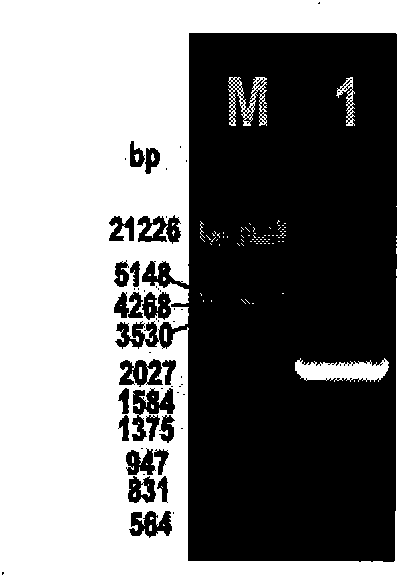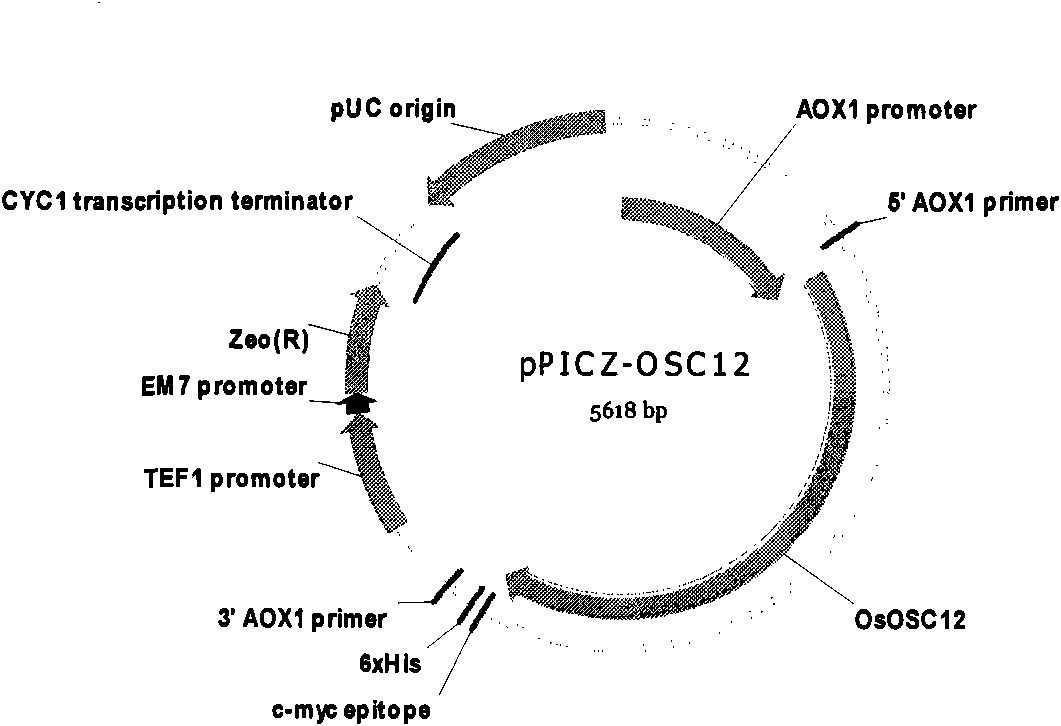Isoarborinol synthesis related protein, and coding gene and application thereof
A technology for encoding genes and proteins, which is applied to the protein related to the synthesis of terpene alcohols in isocaper, and its encoding genes and application fields, can solve the problem of not being isolated from any organism, and achieve the effect of far-reaching application value.
- Summary
- Abstract
- Description
- Claims
- Application Information
AI Technical Summary
Problems solved by technology
Method used
Image
Examples
Embodiment 1
[0043] Embodiment 1, the acquisition of OsOSC12 gene
[0044] According to the blastn search in the NCBI database of the oxidative squalene cyclase (OSC) gene AsCS1 (GenBank Accession Number: AJ311790) and AsbAS (GenBank Accession Number: AJ311789) sequences from oat, 12 homologs were found in the rice genome For the higher full-length cDNA sequence, the following primers were designed according to the nucleotide sequence of one of the genes (OsOSC12):
[0045] 5' end primer: 5'-ATGTGGAGGCTGAAGGTGGC-3';
[0046] 3' end primer: 5'-TCATGCACGCCTCGTGGAG-3'.
[0047] The japonica rice variety Zhonghua No. 11 (Oryza sativa L.spp.japonica) seedling total RNA was used as a template, and the above primers were used for RT-PCR amplification. The specific steps are as follows:
[0048] 1. Extraction of total RNA
[0049] Use the Trizol method (the reagents used were purchased from Invitrogen) to extract the total RNA of 2-week-old seedlings. The specific method is: collect 100 mg of r...
Embodiment 2
[0059] Example 2, the acquisition and identification of OsOSC12 yeast transformed cell line
[0060] 1. Construction of yeast expression vector pPICZ-OSC12
[0061] 1) The pTE-OsOSC12 and pPICZA vectors (Invitrogen) were completely digested with restriction endonuclease Not I, respectively. Enzyme digestion system: 5 μg pPICZA, 2.5 μL 10× digestion buffer, 1 μL Not I, add ddH 2 O Supplement the reaction system to 50 μL. The enzyme digestion reaction conditions are: enzyme digestion at 37°C for 1 hour.
[0062] 2) Separation of the digested products by agarose electrophoresis, recovery of about 2.2kb fragment containing OsOSC12 and about 3kb fragment of pPICZA vector, respectively, dissolved in 20μL ddH 2 O middle.
[0063] 3) The two fragments obtained in step 2) are subjected to a ligation reaction. The ligation reaction system is: 2 μL T 4 DNA ligase, 2 μL 10× ligase buffer, 3 μL recovered DNA fragment containing OsOSC12 gene, 1 μL pPICZA vector fragment. The ligation...
Embodiment 3
[0078] Embodiment 3, cultivating OsOSC12 yeast transformed cells to produce isocaperene alcohol
[0079] 1. Culture of OsOSC12 yeast transformed cells
[0080] Add 25ml of MGY medium (1.34% yeast nitrogen source, 1% glycerol, 0.00004% biotin) to a 250ml culture flask, inoculate a single OsOSC12 yeast transformed cell, and culture with shaking at 28-30°C and 250-300rpm until logarithmic growth is achieved Period (OD 600 =2-6), about 16-18 hours. Collect the cells by centrifugation (1500-3000g, 5min), discard the supernatant, and resuspend to OD with MM medium (1.34% yeast nitrogen source, 0.00004% biotin, 0.5% methanol) 600 =1.0, about 100-200ml. Transfer the culture to a 1L long-necked culture bottle, cover it with 2 layers of sterile gauze and cultivate it for 72 hours, and add 100% methanol every 24 hours to keep the final concentration of methanol at 0.5%. The test set 100 repetitions.
[0081] Cultivate the empty carrier cells, and the operation is the same as above. ...
PUM
 Login to View More
Login to View More Abstract
Description
Claims
Application Information
 Login to View More
Login to View More - R&D
- Intellectual Property
- Life Sciences
- Materials
- Tech Scout
- Unparalleled Data Quality
- Higher Quality Content
- 60% Fewer Hallucinations
Browse by: Latest US Patents, China's latest patents, Technical Efficacy Thesaurus, Application Domain, Technology Topic, Popular Technical Reports.
© 2025 PatSnap. All rights reserved.Legal|Privacy policy|Modern Slavery Act Transparency Statement|Sitemap|About US| Contact US: help@patsnap.com



